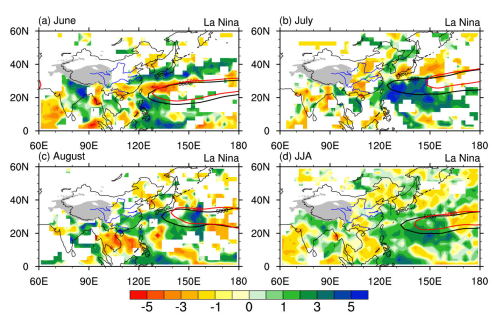
As a result, the WPSH extends more northeastward. This anomalous pattern tends to change with the march of the seasons, with a maximum anomaly in July (Figure 1). The rainfall distribution in East Asia in La Niña summers is characterized by a zonal pattern of less rainfall over eastern China and more rainfall over the oceanic region of the western Pacific. By comparison, a meridional pattern is found in El Niño summers, with less rainfall over the tropics and more rainfall over the subtropics and mid-latitudes.

Figure 1. Rainfall anomaly in La Niña years (units: mm d−1) and the 500 hPa western Pacific subtropical high (units: gpm). Regions with statistically significant results at the greater than 95% confidence level are shaded. The black and red contours represent the WPSH in La Niña years and the climatological mean, respectively. (Image by Xue and Zhao, 2017)
They also find that owing to an earlier eastward retreat of the WPSH in La Niña summers, the seasonal march in East Asia is accelerated, with an earlier onset and termination of the mei-yu season and less rainfall over the Yangtze River basin. Therefore, a La Niña signal is useful for mei-yu prediction. By contrast, the maximum anomaly in El Niño summers is found in August.
"Except in some strong El Niño years, an El Niño signal is of little use to mei-yu prediction, although El Niño signals are statistically stronger than La Niña signals." Prof. XUE observed, "The influence of La Niña is not anti-symmetric to that of El Niño."

86-10-68597521 (day)
86-10-68597289 (night)

52 Sanlihe Rd., Xicheng District,
Beijing, China (100864)

